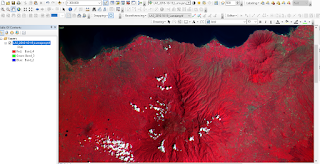The ability to create natural color composites is common for the past of current operational earth observation satellites. Natural color composites can be described as RGB image composites that have a color composition just like our eyes perceive color. In natural color composites, water would have a blue color, vegetation is green, bare soil or built-up landcover would have brownish to reddish color. You can make natural color composites images using satellite data that has blue spectral region of the electromagnetic spectrum of the sun. Imagery from satellites such as Landsat, Sentinel-2, IKONOS, Quickbird, Worldview, Pleiades, Kompsat, Formosat, and many others have a blue band so generating natural color composites would be an easy matter. Things are quite different if we have satellite data that didn't have Blue Band such as ASTER or SPOT. For these kinds of imagery, natural color composites generation must be simulated from the available bands. And the results sometimes woul...



